
by Legalnaija | Nov 6, 2023 | Blawg

Introduction
In an increasingly interconnected world, the digital landscape of any nation is the beating heart of its progress, potential, and prosperity. For Nigeria, a nation teeming with promise, the digital realm represents an unparalleled opportunity to leapfrog into the future. However, like any frontier of promise, this digital landscape is not without its perils. Enter the realm of cybersecurity an omnipresent shield that guards the gates of Nigeria’s digital domain. In an age where data flows like a mighty river, and the lines between physical and virtual reality blur, the significance of cybersecurity to Nigeria cannot be overstated. It’s not merely a matter of safeguarding data; it’s about protecting the very essence of the nation’s growth, security, and resilience.
The implications ripple far and wide, transcending individual businesses and government facilities. In this article, we embark on a journey to unveil the intricate tapestry that is cybersecurity in Nigeria. From the bustling markets of Lagos to the corridors of power in Abuja, from the bustling startups in Port Harcourt to the rural heartlands, this is a story that affects us all.
As we delve into the intricate depths of this discourse, our foremost scrutiny will be directed toward the paramount role played by cybersecurity legislation in molding the nation’s economic landscape, bolstering the security of supply chains, fortifying the integrity of critical infrastructure, and upholding the sanctity of individual privacy and safety. Within this legal odyssey, we shall navigate the labyrinthine confluence of imminent threats and the unwavering resolve to withstand them, acknowledging the inherent vulnerability and cultivating robust digital bulwarks that are not only requisite but fundamental in the protection and preservation of Nigeria’s digital future.

Cybersecurity Landscape in Nigeria: An Overview
The International Telecommunications Union [ITU] defines Cybersecurity as “the collection of tools, policies, security concepts, security safeguards, guidelines, risk management approaches, actions, training, best practices, assurance and technologies that can be used to protect the cyber environment and organization and user’s assets” (Sreenu & Krishna, 2017). ITU also notes that the general objectives of Cyber Security are: Availability; Integrity, (which may include authenticity and non-repudiation), and Confidentiality. Continuous vigilance and adaptation to evolving threats are crucial in maintaining effective cybersecurity (Moreta et al., 2023). Cybersecurity practically acts as the guardian of data quality, preserving trust and the seamless flow of information while shielding against unauthorized access and manipulation. It upholds the essence of a secure digital realm.
The current cybersecurity landscape in Nigeria reflects a dynamic and evolving terrain, marked by both opportunities and challenges. As the nation embraces digital transformation and experiences rapid technological growth, it simultaneously faces heightened cyber threats and vulnerabilities. Nigeria, with its burgeoning digital economy and expanding online presence, has become a prime target for cyberattacks. These threats encompass a wide spectrum, from financially motivated attacks, such as phishing and ransomware, to politically and socially motivated incidents.
In a country where millions of Nigerians engage in daily online activities, from financial transactions to social connections and e-commerce, the digital realm has become an integral part of our lives. The delicate and often sensitive nature of these interactions underscores the critical role of cybersecurity. With online banking, e-commerce, digital communication, and remote work becoming the norm, the nation’s economic and social fabric relies on the sanctity of these digital transactions. The ramifications of a cybersecurity breach can be staggering, ranging from financial losses and personal data exposure to threats to national security. Thus, the importance of robust cybersecurity measures cannot be overstated. As Nigeria accelerates its digital transformation, including e-governance and e-health initiatives, the stakes rise higher. Ensuring the confidentiality, integrity, and availability of digital assets becomes paramount. A secure digital environment not only fosters trust and confidence but also empowers the nation to harness the full potential of the digital age.
The Cyber Security Experts Association of Nigeria (CSEAN) anticipates a gradual escalation in the incidence of cyber threats within the Nigerian landscape, where the Small and Medium Scale Enterprises (SMEs) sector is expected to bear the brunt of these adversities. As per the findings in the CSEAN report, there was an 87% surge in phishing attacks targeting SMEs in 2022, signifying a significant increase from the 37% recorded in 2021.
Cybersecurity Laws and Regulations in Nigeria: Legal Implications and Consequences
Nigeria finds itself at a crossroads where a surge in cybercrimes has reached an alarming magnitude. This multifaceted threat encompasses financial fraud, data breaches, phishing scams, and ransomware attacks. Beyond their digital confines, these perils cast a shadow over the nation’s economic stability, individual privacy, and even national security. In light of this intricate and escalating cybersecurity challenge, the imperative for legal intervention is undeniable. Legal measures must serve as a robust bulwark against the chaos and disarray that these cybercrimes can instigate. The regulatory framework should uphold the rule of law, deter cybercriminals, and ultimately secure Nigeria’s digital future and socioeconomic well-being.
Continuing from the preceding context, let us delineate several of the extant regulatory frameworks that pertain to cybersecurity in Nigeria;
- Cybercrimes (Prohibition, Prevention, Etc.) Act 2015.
- Nigeria Data Protection Regulation 2019.
- National Cybersecurity Policy and Strategy, 2021.
- Nigeria Data Protection Act 2023 (NDPA)
The Cybercrimes (Prohibition, Prevention, Etc.) Act according to its objectives provided in section 1 of the Act was created to establish an efficient and comprehensive legal and regulatory structure to address cybercrimes in Nigeria, safeguard critical national information infrastructure, and enhance cybersecurity measures, including data protection and privacy rights.
Part 3 of this Act meticulously delineates actions that qualify as offenses, along with the corresponding punitive measures prescribed for each transgression. These transgressions encompass a range of activities, including, but not restricted to: unauthorized access to computer systems, violations against critical national information infrastructure, acts of system interference, interception of electronic communications, such as messages and emails, illicit electronic fund transfers, phishing schemes, unsolicited mass emails (spam), propagation of computer viruses, and computer-related fraudulent activities. It is imperative to underscore that each of these infractions carries a unique sentencing regime, with certain egregious transgressions not affording the option of a pecuniary fine due to the gravity of their impact.
Furthermore, the statute also imposes a set of obligations upon individuals or entities engaged in the operation of computer systems or networks. Among these obligations is the compelling duty to promptly report any instances of cyberattacks or intrusions to the Computer Emergency Response Team (CERT) Coordination Center, facilitating the swift enactment of necessary remedial actions. Failure to comply with this specific duty is met with a substantial penalty of 2,000,000 naira and a seven-day suspension of internet service.
It is noteworthy that a subset of these offenses possesses a technical intricacy that necessitates the expertise of a qualified professional to ascertain whether a given action qualifies as an offense under the purview of this legislation.
The Nigeria Data Protection Act being the latest legislative framework governing the domains of data privacy and security, meticulously delineates the obligations bestowed upon data controllers and processors concerning their responsibilities to safeguard the data placed in their custody directly and indirectly by the data subjects. The legislation establishes a commission entrusted with the critical mandate of overseeing data controllers, ensuring that they do not overstep the bounds of authority granted to them by data subjects. This commission is tasked with evaluating the conduct of these data controllers to ascertain their compliance with the stipulations outlined in the Nigeria Data Protection Act (NDPA).
The legislation has seamlessly integrated globally recognized best practices within its provisions, particularly on the obligations and standards imposed upon data controllers in the realms of data processing, data transfer, and various other relevant facets.
The Nigeria Data Protection Regulation was not invalidated by the emergence of the NDPA. However, the Nigeria Data Protection Act (NDPA), being a primary national legislation, holds precedence over the Nigeria Data Protection Regulation (NDPR), which is categorized as subsidiary legislation. Importantly, it is crucial to note that the NDPA, while exerting its legal authority, does not nullify or revoke the NDPR. Rather, the NDPA explicitly stipulates that all regulations promulgated by the National Information Technology Development Agency (NITDA), encompassing the NDPR, maintain their legal validity and remain in effect, as though they were originated or endorsed by the Nigeria Data Protection Commission (NDPC).
The National Cybersecurity Policy and Strategy, The policy document embodies a comprehensive and adaptable framework, placing significant emphasis on the collaboration between the government, the private sector, and citizens to safeguard digital ecosystems. Nigeria aspires to cultivate strong legal and regulatory frameworks that can effectively combat cybercrime, fortify the protection of critical infrastructure, and ensure the privacy of data. This endeavor seeks to be accomplished through the persistent monitoring of cyber threats, the development of incident response plans, and the implementation of public awareness campaigns, all of which are pivotal components aimed at nurturing a resilient cyber landscape conducive to sustainable growth and the secure advancement of digital transformation.
Common Cyber Threats in Nigeria
In the digital age, the pervasive nature of cyber threats casts a daunting shadow over our interconnected world. The dangers are manifold, ranging from data breaches and financial fraud to critical infrastructure disruptions and even threats to national security. What fuels this digital menace is a complex interplay of factors, including the ever-evolving sophistication of cybercriminals, the lucrative nature of cybercrime, and the relative anonymity provided by the digital realm.
While the digital landscape offers boundless opportunities, it also harbors threats that thrive in the nation’s evolving cyberspace. Reports of phishing scams, online fraud, and data breaches paint a picture of a thriving cyber underworld. The reasons behind this growth include a lack of comprehensive cybersecurity infrastructure, limited awareness, and a need for robust regulatory frameworks. Understanding the dynamics of these threats is paramount, for it is only through this understanding that we can hope to fortify our defenses and ensure a secure digital future in Nigeria. Here are some of the prevalent cyber threats wreaking havoc in Nigeria:
- Phishing Attacks
- Ransomware
- Business Email Compromise (BEC)
- Distributed Denial of Service (DDoS) Attacks
- Identity Theft
- Malware Infections
- Online Fraud
- Data Breaches
- Insider Threats
- Social Engineering Scams
These threats collectively pose significant challenges to cybersecurity within the nation, thriving on the unsuspecting and the unprepared. These threats each with distinct characteristics and potential ramifications. Phishing attacks cunningly manipulate human psychology, tricking individuals into divulging sensitive information or falling prey to malicious links. Ransomware, the merciless extortionist, encrypts vital data, demanding cryptocurrency payments for its release. Business Email Compromise (BEC) infiltrates corporate email accounts to initiate fraudulent transactions or financial manipulations, while Distributed Denial of Service (DDoS) assaults inundate digital services with traffic, rendering them inaccessible. Identity theft is the stealthy theft of personal information, which can lead to financial ruin and reputation damage. Malware infections propagate malicious software, compromising security, and spreading chaos. Online fraud schemes perpetrate scams and deception for financial gain. Data breaches compromise confidentiality, often exposing private data to unscrupulous entities. Insider threats arise from within an organization, posing risks to its assets. Social engineering scams craftily manipulate victims into revealing confidential information.
In 2020, Nigeria secured an unfortunate 16th place in the global ranking of countries most severely impacted by cybercrime. A recent development within Nigeria’s cyber threat landscape has unveiled a rather alarming trend: hackers are strategically enticing employees of Nigerian organizations to act as insider threats. Revelatory research indicates that these hackers are offering financial incentives to employees in exchange for access to sensitive information within an organization’s network. While specific instances of staff succumbing to such temptation were not documented, this emerging scenario is undeniably a cause for growing concern. The third quarter of 2022 bore witness to a staggering 1616% surge in data breaches in Nigeria, escalating from 35,472 incidents in the second quarter to a daunting 608,765 occurrences in the third. This unnerving spike signals a pressing need for enhanced cybersecurity measures. In a commendable stance against cybercrime, Nigeria’s Economic and Financial Crimes Commission (EFCC) has undertaken a proactive campaign in 2022, successfully convicting 2,847 individuals involved in cyber-related crimes. This marks a significant stride in the fight against cybercriminals who threaten the nation’s digital landscape and the security of its citizens.
Safeguarding Digital Assets: Best Practices
In a digital landscape fraught with risks and vulnerabilities, the need to adopt cybersecurity best practices has never been more pressing. Healthcare and financial organizations, in particular, find themselves squarely in the crosshairs of cyber threats. To safeguard sensitive data, financial assets, and the trust of their clients, individuals, and entities in these sectors must embrace the proactive measures explored in this section.
- Detecting External Security Flaws: Cybercriminals frequently zero in on organizations lacking robust security protocols, and healthcare and financial institutions are prime targets due to various vulnerabilities. In healthcare, the extensive array of internal systems often remains unpatched, granting cybercriminals easy access. Limited IT resources compound the problem, resulting in outdated security protocols. Furthermore, inadequately secured healthcare member portals can expose patient data to potential breaches. Financial service sectors encounter similar challenges as they modernize their infrastructure, transitioning from legacy systems to digital platforms. During this transition, cybersecurity gaps may inadvertently open doors for malicious actors. Criminals strategically target financial institutions, well aware of their capacity to meet ransomware demands, making them high-value targets in the digital realm.
- Conducting Penetration Tests: Penetration testing is a proactive approach employed by companies to uncover potential security vulnerabilities. By emulating hacker tactics, this method aims to detect and address security weaknesses before they can be exploited. Simulated cyberattacks are designed to exploit existing vulnerabilities, providing valuable insights to fortify defenses and protect sensitive data.
In the healthcare sector, adherence to HIPAA guidelines necessitates robust testing to ward off potential breaches. Similarly, financial institutions must follow government regulations for safeguarding consumer data. In both cases, IT teams play a crucial role in identifying and addressing security system vulnerabilities through comprehensive testing.
- Risk Prioritization Based on Business Impact: After identifying vulnerabilities in your assets, the next crucial step is to prioritize them according to the potential risks they pose to your organization. This prioritization process guides your efforts in enhancing security and establishes benchmarks for future assessments. To streamline this process, security ratings come into play. These ratings assign a letter grade to your security posture, reflecting how effectively it safeguards vital data and information. This grading system offers clarity, highlighting areas that demand immediate attention within your security framework. Additionally, these ratings prove valuable in third-party risk management, showcasing your commitment to due diligence during vendor onboarding and ongoing monitoring.
- Utilize Automated Cybersecurity Solutions: Incorporating automation into your corporate network environment plays a pivotal role in risk reduction and security enhancement. Automated cybersecurity solutions prove invaluable in network monitoring, offering IT teams the gift of time to concentrate on addressing high-risk threats.
Moreover, these automated solutions excel in reducing incident response times and swiftly curbing the propagation of attacks across networks. When appropriately configured, automated resources can extend their capabilities to assess security metrics. It is highly advisable to focus on metrics conducive to the automated gathering of data for comprehensive cybersecurity management.
- Stay Current with Regular Updates: Staying at the forefront of cybersecurity defense mechanisms is essential to ensure your security remains resilient. Regular updates and modifications are indispensable, as they empower IT teams to adapt to evolving security technology and emerging threats promptly.
- Develop an Effective Incident Response Plan: Preparedness is key in cybersecurity. An incident response plan, including dedicated teams and action checklists, minimizes harm and enables a swift recovery. The plan’s complexity varies with the attack and organization size. Regularly update and rehearse the plan for optimal performance and adaptability in the face of evolving cyber threats.
Safeguarding digital assets is an ongoing endeavor, necessitating the expertise of adaptable and continuously learning security professionals. As the threat landscape constantly evolves, these individuals must remain at the forefront of emerging trends, ensuring they are well-equipped to thwart even the most sophisticated cyberattacks. The resilience of organizations, the protection of sensitive data, and the preservation of trust in the digital age hinges upon the dedication and vigilance of such security experts.
Conclusion
The realm of cybersecurity in Nigeria stands at a critical juncture. While existing laws make strides in addressing cyber threats, more stringent measures are imperative to deter the audacity of cybercriminals and bullies. The role of legislation extends to ensuring the unwavering adherence of organizations, particularly public entities, to robust cybersecurity best practices. With public organizations safeguarding highly sensitive data, their commitment to data protection is not just an obligation; it is a covenant of trust with the public they serve. The future of cybersecurity in Nigeria hinges on the unwavering resolve of lawmakers and organizations to fortify digital defenses, guaranteeing the resilience and integrity of our digital landscape.

by Legalnaija | Nov 6, 2023 | Blawg

Sports right from its inception has predominantly been for entertainment purposes. However, the concept of rewarding winners in these sporting competitions and the egoistic nature of man have made sports more than just entertainment for these athletes, who also want to be recognized as some of the best in their field.
It is often misconceived that the ban on the use of performance-enhancing drugs in sports was just to eliminate the undue advantage that these persons have against their opponents who do not use these drugs. While this was an important factor taken into consideration in the full deliberation, another factor was also as important if not more important. This factor is the issue of the health of these athletes who partake in the use of these drugs. The intake of some of these banned substances can lead to Cardiovascular problems, liver and kidney damage, lead athletes to addiction, and many other temporary and permanent health concerns. The dangers of these performance-enhancing drugs have led to the formation of several organizations and agencies to help regulate the growing issue of doping, one of these organizations is the World Anti-Doping Agency (WADA)
World Anti-Doping Agency (WADA)
The World Anti-doping Agency is an organization set up on 10 November 1999 in Lausanne, Switzerland. The International Olympic Committee (IOC) spearheaded the motion to establish this foundation to combat the ever-growing concerns of doping in the sports ecosystem. The agency’s official headquarters is situated in Montreal, Quebec, Canada while the office at Lausanne now serves as the regional office in Europe.
WADA works in collaboration with many national and international sports federations, and other stakeholders to establish and enforce the World Anti-Doping Code, a set of anti-doping rules and regulations that apply to all athletes and support personnel worldwide. This agency maintains a prohibited list of substances and methods that are banned in sports, it is a flexible list and it gets updated annually to reflect different research in the field of medicine.
The interference of different regulatory bodies on the issue of doping in sports is predicated on well-analyzed reports pointing towards the short and long-term negative impact of doping on not just the athletes but also the sports events involved and most importantly, sports in general.
“Sanctions serve as a lesson for Wayword deeds” mischievous actions that defy the norms, can trigger reactions, unleashing storms. Sanctions can befall, harsh yet fair, a price to pay for those who dare. Sanctions are provided under regulations that are set to keep the chaos in check.
The Legal Repercussions of Using Performance-Enhancing Drugs in Sports
The idea of law and sanctions in curing mischief is based on the principle that individuals who engage in harmful or unethical behavior should be held accountable for their actions and face consequences as a deterrent to future wrongdoing. The use of laws and sanctions to prevent mischief can take many forms, including fines, imprisonment, community service, and other forms of punishment. Laws and sanctions can serve as a means of deterrence by sending a clear message that certain behaviors are not acceptable and will be met with consequences. They can also provide a sense of justice to victims of mischief and serve to restore public confidence in the rule of law.
The legal implications of using performance-enhancing drugs in sports carry jurisdictional flavor meaning that different jurisdictions treat their cases differently but in generality, the issue of doping in sports is no light matter. A critical appraisal of this is best done by examining some of the legal implications enforced by most internationally recognized sports organizations such as the International Olympics Committee (IOC), Fédération Internationale de Football Association (FIFA), world Anti-Doping Agency (WADA), Union of European Football Association (UEFA) and so on;
- Disqualification and Forfeiture Medals and Prizes: This is predominantly what most sports organizations go with and some of the world’s greatest athletes have been on the receiving end of this. Ben Johnson, a Canadian former sprinter, was widely recognized as one of the world’s fastest men. In the 1988 Seoul Olympics, Ben Johnson came through, grabbing with him both the gold medal in the 100m sprint and more impressively shattering the world record at that time, finishing with a time of 9.79 seconds. However, he was to enjoy this galore for just a few days as the International Olympic Committee (IOC) sanctioned him for doping, amongst many other sanctions handed him were disqualification from the race and making him forfeit his gold medal. Ben Johnson was found to have tested positive for the anabolic steroid stanozolol, which is a synthetic steroid that is commonly used by athletes to enhance their performance by increasing muscle mass and strength.
- Payment of Fines: Several factors impact the weight of the fine to be levied on athletes caught doping, the substance taken, the financial strength of the athlete, how many times the athlete has been found in violation, and the governing body sitting on the case. Fines as high as $250,000 have been slapped on athletes for doping as seen in the popular 2016 case of Tennis star, Maria Sharapova. Sharapova tested positive for a banned substance, Meldonium at the Australian Open. Meldonium is believed to improve endurance, reduce fatigue, and enhance recovery time, which could provide an unfair advantage to athletes who use it. Its ban has been a controversial topic in the sports world as it has been argued that evidence of its performance-enhancing effects is not strong enough to warrant a ban, but it is still recognized as a banned substance and still makes the list of banned substances according to World Anti-Doping Agency (WADA).
- Contractual Disputes: Sponsors and employers who are contracted to these athletes most times have zero tolerance for doping and often include doping in the termination clause as a cause to terminate the contract between them and the athletes. In some situations, things get messy to the extent that parties involved in the contract are before the court seeking its intervention. In the 2016 case of Maria Sharapova, after the tennis star tested positive for the banned substance, she lost several endorsement deals, one from Nike. Sharapova instituted legal proceedings against Nike, arguing that Nike had breached the contract between them as they did not provide her with sufficient notice and an opportunity to cure any breach before terminating the contract. In the end, Nike agreed to pay Sharapova an undisclosed amount, it was reported that Sharapova would receive compensation for the remaining value of her contract with Nike, which was worth about $70 million over eight years.
- Criminal Charges/Investigation: Largely doping does not attract criminal charges but in some jurisdictions, effective efforts have been made toward strictly policing doping. In Germany, there is the Germany Anti-Doping Act. The act was enacted in 2015 and it criminalizes the use, possession, and distribution of doping substances. This law applies to every sport in Germany. Athletes who obtain banned substances through prescription fraud, such as forging prescriptions or obtaining them through unlicensed sources can face criminal charges in the United States of America for charges related to fraud and drug trafficking.
- Ineligibility for Future Events/Tournaments: Athletes found guilty of violating anti-doping regulations, most often are suspended from competing in future tournaments at least for a limited timeframe. Maria Sharapova was suspended from competing in any tennis event for 15 months by the International Tennis Federation. In some cases, even when the period of suspension is over, some tournament organizers are reluctant to invite these athletes to their events. Justin Gatlin is a true victim of organizers’ reluctance to invite athletes with past doping records. In 2015, the organizers of a Diamond League track and field meeting in Shanghai, China, refused to send out an invitation to Gatlin citing their policy of not inviting athletes who have been convicted of doping charges.
- Loss of Records: Numerous world records set in the past have been expunged from history and it is now like they never happened just because the athletes with these records are doping. It is important to note that testing positive for banned substances even after the tournament could be enough to erase the record set. Sometimes suspicions might lead to an athlete getting tested after the event. However, the type of banned substance and the organization governing the tournament will determine the severity of the case.
- Reduced Funding: It is not inconceivable that events rocked by the doping crisis will find it tough to secure funds for subsequent events. Just as in the case of sponsorship for athletes, brands do not want to work with organizations or persons that will smear the brands’ image in the eyes of the public. The Tour de France, which is one of the most recognized cycling races in the world lost one of its most dominant sponsors, Credit Lyonnais as a result of several consistent doping scandals in the sport.
- Increased Regulations on doping matters: Laws and regulations have always been a means of encouraging positive behavior and curtailing mischievous habits. It is these tools that organizations and event organizers employ to restrain players from resorting to doping. These regulations are sometimes made stricter and drug tests more frequent in such a way that it becomes practically impossible to dodge.
CONCLUSION
Athletes are responsible and strictly liable for any substance found in their bodies and as so athletes are to treat their bodies as a temple. The athlete is to handle his/her body as a job and be very cautious of all food intake and products they use on their body. Medications and supplements taken by these athletes might contain banned substances that the athlete unknowingly consumes. There is a possibility that an environment heavily polluted with banned substances can be dangerous to the athlete as he/she might inhale enough concentration that can show up during drug tests. It is advised to be well aware of all banned substances to avoid mistakes along the way. Doping has ruined many careers and erased many established careers just like Lance Armstrong who had all his cycling accolades taken after it was found that he was doping his whole career. Doping generally undermines the integrity of sports and will always be given zero tolerance.
Relevant Materials
- “Maria Sharapova Sues Nike Over Termination of Contract After Doping Scandal.” The Guardian, 14 Mar. 2018, theguardian.com/sport/2018/mar/14/maria-sharapova-sues-nike-over-contract-termination-after-doping-scandal.
- “About Us.” World Anti-Doping Agency, https://www.wada-ama.org/en/about-us.
- “Prohibited List.” World Anti-Doping Agency, https://www.wada-ama.org/en/what-we-do/prohibited-list.
- https://www.nytimes.com/2013/10/23/sports/cycling/lance-armstrong.html
- https://www.wada-ama.org/en/what-we-do/prohibited-list
- https://www.nytimes.com/2006/07/30/sports/30iht-doping.2322317.html
- https://www.theguardian.com/sport/2015/nov/05/justin-gatlin-olympic-sprinter-banned-doping-offence
- Photo: www.procon.org
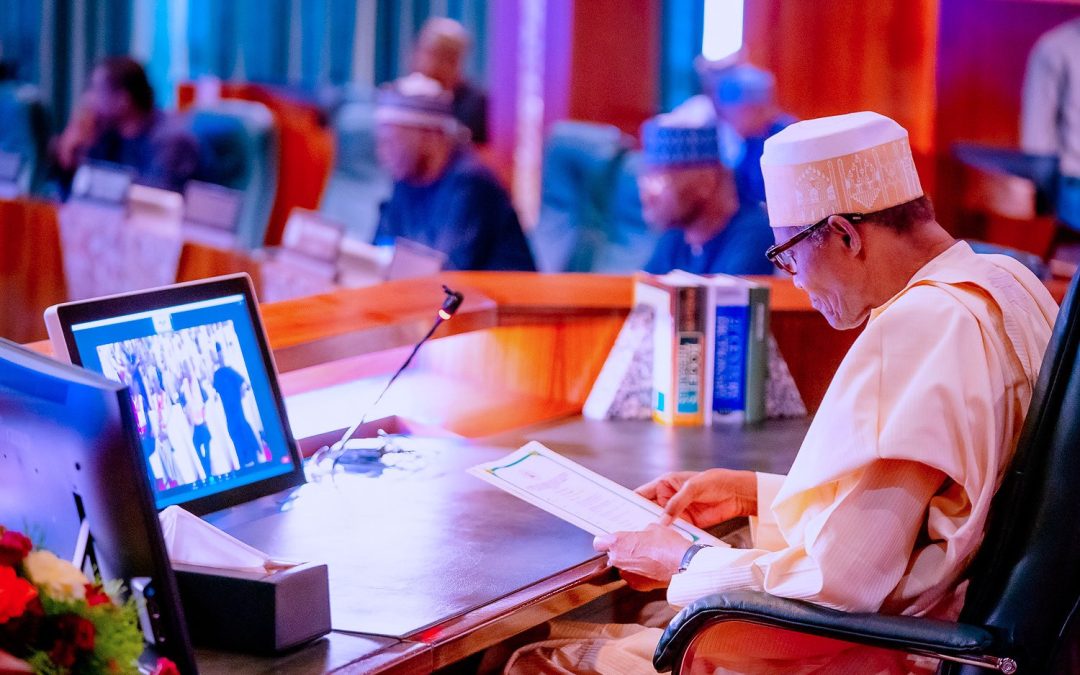
by Legalnaija | Oct 30, 2023 | Blawg
A MATTER OF PRINCIPLE| Muhammadu Buhari
RARELY in modern times can so few have tried to take so much from so many. If Nigeria had lost its arbitration dispute with Process & Industrial Development in a London court on 23 October, it would have cost our people close to USD15 billion.
We won, and all decent people can sleep easier as a result. Justice Robin Knowles said Nigeria had been the victim of a monstrous fraud. But it was a close-run thing. As the judge said: “I end the case acutely conscious of how readily the outcome could have been different, and of the enormous resources ultimately required from Nigeria as the successful party to make good its challenge.”
But ordinary Nigerians never took the decisions that ended up before Justice Knowles. Had Nigeria lost, it would have required schools not to be built, nurses not to be trained and roads not to repaired, on an epic scale, to pay a handful of contractors, lawyers and their allies – for a project that never broke ground.
How did it get to this point? How did Nigeria prevail? Was this a one-off, or par for a shabby and distasteful course? What are the lessons for the future?
The ‘P&ID Affair’ was already firmly set by the time I came into office in 2015. A company registered in the British Virgin Islands that no one had heard of, with hardly any staff or assets, had won a contract to build a gas processing plant in Cross Rivers. The company was owned by Irish intermediaries who knew Nigeria well and had done business in everything from healthcare to fixing tanks.
The previous government could not supply the gas. The plant was never built. Construction was not started. P&ID did not even buy the land for the facility. But the contract, incredibly, was clear: P&ID could sue Nigeria, and claim all the profits it might have made over 20 years as if everything had been completed.
Nigeria was in court in London, trying to talk down liability and costs. Back at home, fixers were looking to work out a quiet settlement. This is often the way. A lot of contracts end up in dispute. P&ID won a settlement in 2017 of USD6 billion, with compound interest. People, including out of work ex-British Cabinet Minister Priti Patel, were queuing up to insist we paid, or risk Nigeria becoming an untrustworthy trade pariah.
It was clear that far from the whole story had been told. I tasked Abba Kyari, my chief- of-staff and Attorney General of the Federation, Abubakar Malami, with finding a way, even at that late stage and despite so much conflicting advice, to get us a fair hearing. Working with a number of different agencies and senior officials of government, we began to find a huge amount of evidence, not all of which Justice Knowles was to accept. But he agreed that P&ID had paid bribes. He agreed that one of P&ID’s founders had committed perjury. And he agreed that P&ID had somehow found in its possession a steady supply of Nigeria’s privileged internal legal documents, outlining our plans, strategies and problems.
My own view is that this whole, sorry affair shows how important it is to follow the legal process in resolving a dispute. It shows that given time and opportunity for each side to present their case, the temple of justice can satisfactorily resolve all disputes without resort to extra-judicial measures. It was definitely worth the struggle: this was an attempted heist of historic proportions, an attempt to steal from the treasury a third of Nigeria’s foreign reserves.
But even at this moment, we should note what the English judge cautioned. The arbitration process in London “was a shell that got nowhere near the truth.” We need better contracts, in the public and private sector. And we need greater transparency: the reality is that, had P&ID not conjured up quite such an outlandish ransom, they may have found themselves in the same place as the myriad other invisible contractors who all too often quietly take Nigeria for many millions in out of court settlements. Sterner sanctions are indicated for Nigerian public officials who have been proven to connive with foreign criminals to defraud our country.
Nigeria has won this battle with corruption, but the war is far from over. As Justice Knowles concluded: “This case has also, sadly, brought together a combination of examples of what some individuals will do for money. Driven by greed and prepared to use corruption; giving no thought to what their enrichment would mean in terms of harm for others. Others that in the present case include the people of Nigeria, already let down in so many ways over the history of this matter by a number of individuals in politics and administration whose duty it was to serve them and protect them.” Well said.
Muhammadu Buhari served as President of the Federal Republic of Nigeria 2015-23

by Legalnaija | Oct 16, 2023 | Blawg
PRIVCON PRIVACY AWARDS: CALL FOR NOMINATION
The conveners of PrivCon Nigeria – an annual privacy and data protection conference in Nigeria – are delighted to announce the call for nominations into varying categories of their inaugural PrivCon Privacy Awards 2024. These awards have been established to identify and celebrate outstanding contributions to the growth and development of privacy and data protection in Nigeria.
Nominations are now open into the following categories:
- Privacy Leading Light (Legal) for lawyers in private practice or in-house counsel.
- Privacy Leading Light (Tech)– Privacy professionals in tech (non-lawyers)
- Privacy Leading Light (Academics): University lecturers teaching law, cybersecurity, ICT and other related courses.
- Privacy Leading Light (Research): Researchers with published works in the area of privacy, data protection, cybersecurity or related subjects.
- Privacy Leading Light (Women category): Women in tech, female lawyers
- Privacy Leading Light (Advocacy): Non-governmental organisations leading privacy/data protection advocacy in Nigeria.
- Privacy Team of the Year (Private sector): Private and public companies with formidable privacy departments.
- Privacy Team of the Year (Public sector): Government agencies with formidable privacy departments.
- Best Privacy Culture Development: Nigerian Organisations with the best privacy culture
- Best Privacy Product/Programme: Nigerian Companies with privacy-enhancing products or programmes
- DPO of the Year (private sector): DPOs in private or public companies.
- DPO of the Year (public sector): DPOs in government departments
- DPCO of the Year: licenced DPCOs in Nigeria
- Rising star (Legal): young lawyers (1 -5 years post-call)
- Rising star (Tech): young privacy professionals (1-5years experience)
- Rising star (Undergraduate): University students (including postgraduate and law school)
Nominations are invited from individuals, organizations, and entities who have made significant strides in promoting the privacy and data protection industry in Nigeria. Please consider submitting nominations for deserving candidates in these categories.
HOW TO NOMINATE:
Head over to PrivCon Privacy Awards website at www.privconprivacyawards.ng. Fill out the nomination form with the required information. Include a detailed description of the nominee’s contributions and why they deserve recognition in the selected category.
NOMINATIONS TIMELINE:
Call for Nominations Opens:16th October 2023
Nominations Deadline: 30th November 2023
Shortlisted Nominees Announced: 7th December 2023
Voting starts: 8th December 2023
Voting closes: 8th January 2024
Final Nominees Announced: 31st January 2024
Panel of Judge Announced: 1st February 2024
Awards Ceremony: April 2024
For any inquiries or require assistance, please contact host@privconnigeria.ng
Join us in celebrating those who have made significant strides in advancing privacy and data protection in Nigeria.

by Legalnaija | Oct 14, 2023 | Blawg
Criminal Instinct; Inborn Or Socially Imbibed[1]
CRIME FACTORS
- CONSTITUTIONAL/ENVIRONMENTAL FACTORS
Research had been carried out and it is deduced that to ascertain the causes of crime, the researcher must start somewhere, which necessitates some assumptions. The most popular presumption is that criminal behavior results from constitutional, environmental, and psychological factors operating either alone or in concert with one another on the offender. The presence of these forces must be dealt with as best as we can while keeping in mind the significant degree of overlap between them, even though their intensity and size are not now subject to precise measurement.
I allude to the physical traits that predispose the offender to act in the manner he does when I talk about constitutional variables in crime causation. These physical traits may be long-lasting or fleeting. Drunkenness is an example of a temporary criminogenic factor, although a physical condition like dwarfism may be a lifelong criminogenic predisposing factor. Studies on heredity, twins, hormones, and physical appearance all provide support for the constitutional tendency to criminal behavior at this time.
Early phrenologists, or men who sought to establish a link between the skull, the brain, and social behavior, are credited with starting the scientific study of these topics. Franz Joseph Gall[2] believed that the physical makeup of the skull and the structure of the brain was connected to a person’s propensities for particular types of behavior, including criminal behavior. But Lombroso was the one who popularized this anthropological theory of criminal behavior. The study that disproved the accuracy of anthropological beliefs was conducted by Dr. Charles B. Goring, an English jail doctor. In his book The English Convict,[3] Goring summarizes his research, which he conducted using control groups and statistical methods Pearson developed at University College, London.
2. HEREDITY
Numerous observers have remarked how frequently criminal behavior in children matches criminal behavior in parents or siblings, and some have concluded that a propensity for criminal behavior is an inheritable trait. Studies of ‘criminal families’ such as Richard Dugdale’s The Jukes,[4] Estabrook’s and Davenport’s The Nam Family,[5] and Henry Goodard’s The Kallikaks[6] have been used in support of this conclusion.
In Nigel Walker’s words, most delinquent children have lived with their delinquent parents or siblings long enough to acquire ways of life by imitation or some other non-genetic process of transmission.[7] Nevertheless, Cyril Burt came to the opinion that constitutional considerations are important in determining juvenile delinquency, but it would be erroneous to assume that every criminal is a helpless victim of his predisposition to crime.[8]
3. TWINS
The age-old and crucial question in criminology is “nature vs. nurture.” The studies of twins that examined the degree of concordance or discordance in the criminal behavior of monozygotic (identical) and dizygotic (non-identical) twins have proven to be the most effective means of addressing it. Monozygotic twins are produced when a single ovum is fertilized and separated into two separate embryos, each of which has an identical set of genes. These monozygotic twins are always identical in terms of sex, blood type, and appearance. On the other hand, the simultaneous fertilization of two ova by two spermatozoa leads to the development of dizygotic twins. These twins, which could be made up of one male and one female, two males, or two females, do not have genetically identical sets. Both of them may or may not share the same blood type, and they may or may not look alike.
When it comes to behavior, twins who display the same behavior are considered to be concordant in that regard. When it comes to the behavior aspect, twins that display divergent behavior are considered to be discordant. In this sense, two twins with the same genetic complexion are said to be concordant. This trait may be the result of genetic transmission if monozygotic twins exhibit a much higher rate of concordance with the trait of criminal behavior than dizygotic twins. Medical research has shown that at least one type of abnormal behavior, the symptom caused by Huntington’s chorea,[9] is genetically transmitted. Monozygotic twin pairs have also been reported to have high concordance rates for alcoholism, idiopathic epilepsy, and schizophrenia.[10]
According to Walker,[11] incorrect categorization will most frequently result in dizygotic being labeled as monozygotic, which will if anything, lower the concordance rate. One can only presume that the investigator was aware of the issue of prejudice and took appropriate action in response to the second criticism. The use of monozygotic twins who were raised in different circumstances is the only way to address the last complaint, which is of course the most serious. Studies in this vein have proved ‘that there are a marked genetic factor underlying measurable traits of personality, such as extraversion and neuroticism, and of course intelligence.’[12]
There is strong but not conclusive evidence based on unseparated twins for a partial determination of ‘criminality, by genetic inheritance; and fairly conclusive evidence, based on separated and unseparated twins, for a similar determination of at least two personality traits. The onus of proof, therefore, seems to lie on those who wish to explain away the higher concordance rates for delinquency in monozygotic.[13]
4. ENDOCRINOLOGY
Some have hypothesized that endocrine disorders in the individual are a contributing factor in criminality generally and particularly in the case of sexual offenses. In their book The New Criminology,[14] Schlapp and Smith made an effort to explain why there was a high rate of crime among immigrant parents’ first-born children in America by claiming that the mother’s glandular disorders were caused by the stress of immigration. The authors postulated that their offspring received this glandular imbalance from them. Children that were born later were not affected once the mother’s problems calmed. Hormonal therapy and castration of sexual offenders, both essentially presume an endocrine foundation for the proscribed behavior, have neither had outstanding outcomes nor been free of debate.[15]
5. PHYSIQUE
Ernst Kretschmer, a well-known German psychiatrist, contributed significantly to the field of serious investigation on the relationship between body composition and personality. He was able to prove beyond a shadow of a doubt that different body types are associated with particular types of mental diseases. For instance, he found a link between schizophrenia and an athletic body type. The work of Sheldon and the Gluecks in America may be credited to Kretschmer for having first connected bodily kinds (somatypes) to criminality. Kretschmer continued to make this connection. Sheldon defined four body kinds, or somatypes, based on his system of categorizing body types, which is predicated on the idea that a particular type of tissue will predominate in every individual.
- The endomorph in which fatty tissue predominates. This type is given to food, drink, comfort, company, and sleep.
- The ectomorph in which skin and the nervous system predominate. This type is given privacy, is sensitive to pain, needs sleep, and is youthful in appearance.
- The mesomorph is in which bone, muscle, and sinew predominate. He is insensitive to pain and is given to movement and aggression.
The balanced type or that body build in which equal amounts of the features of the preceding types are found.
6. MENTAL FACTOR
Mental disease, as opposed to mental sub-normality, is always characterized by the affected person’s persistent inability to live up to the expectations of the reality in which he or she is immersed. Because it is famously difficult to distinguish between periodic and constant failure, the literature frequently uses varying language and lacks accuracy. As a result, the interested person has a lot of latitude in how he constructs his thinking on the matter. The ideas of intellect, emotional maturity, and persistence have all been utilized in attempts to isolate, stabilize, and quantify components of mental existence. Intelligence is the ability to successfully adapt behavior to changing circumstances and to learn from experience. When it comes to pursuing action that is motivated by intelligence, emotion, or both, persistence is the opposite of emotional adjustment, which is the ability to reconcile one’s thoughts about things.
It is obtained that the mother is the primary caregiver for a child’s emotional needs from birth to age four, and this is crucial for healthy growth. The child starts to develop long-lasting relationships with others between the ages of four and seven, and father-child relationships become significant. The child’s intelligence is gradually growing at the same time that this emotional pattern is taking shape. The child’s ability to develop mentally depends on how well his emotional and intellectual growth keeps up with one another. His intelligence is known to rise throughout infancy, peaking between the ages of fourteen and sixteen, and then remain constant at that level until the second half of his life when it starts to fall.
For an informal discussion, mental diseases are frequently separated into two major categories: organic and functional. Organic mental illness is dependent on a specific physical illness, such as advanced syphilitic infection or drug use. Functional mental diseases are those that ‘have not yet been shown to have a clear physiological cause.’[16] They are recognized psychologically as opposed to physically. Examples of mental disorders with a functional origin include anxiety and hysteria.
7. PSYCHOSES
The general paralysis of the insane (dementia paralytica) caused by syphilitic infection, traumatic psychoses brought on by accidents, encephalitis lethargica, senile dementia, puerperal insanity, epilepsy, intoxication, psychoses, paranoia, paraphrenia, mania, and schizophrenia are the psychoses that are of interest from a criminological perspective.
- General paralysis of the Insane due to Syphilitic Infection
An overall decline in the quality of the person’s entire personality is a symptom of this psychosis. Antisocial behavior, such as theft, fraud, forgery, and violence performed without any attempt at covertness, sometimes precedes the onset of clinical symptoms. In the lack of clinical signs, these people may be mistakenly held responsible for their actions.
- Traumatic Psychoses Caused by Accidents
There have been cases when brain injuries were followed by pronounced personality changes, including an excess of sensitivity to the effects of alcohol, excitability, and a propensity for violent crimes. The punch-drunk boxer’s antisocial behavior is a hallmark of this type of psychosis.
- Encephalitis Lethargica (Sleeping Sickness)
An inflammation of the brain is caused by psychotic fever, which is ‘typically followed by serious and long-lasting aftereffects and changes in physique, intelligence, and character.’[17] The post-encephalitic stage is characterized by ‘committing thefts, assaults, acts of cruelty, or sexual misdemeanors’ by the patients. Only placing them in specialized hospitals is something that can be done.[18]
The organic psychosis known as epilepsy is commonly linked to criminal activity. Unconsciousness, convulsions, and uncontrollable body movement may result from the brain’s normal electrical activity being incredibly erratic and violent. A typical epileptic seizure follows. This disturbance, nevertheless, can be less severe and the epileptic features hardly noticeable. Although these epileptic seizures can sometimes be created intentionally, in the case of the actual epileptic, they are brought on by relatively unidentified internal impulses. In some epileptics, the focal point of the severe electrical activity surges has been seen to be damaged areas of the brain. It is well-recognized that some illnesses and poisonings can cause epilepsy.
It is often said intoxication leads to psychosis,[19] when it does we may be treated to the situation found in R. v. Hartridge[20], where Hartridge shot his wife to death while he was in a highly intoxicated state. Hartridge didn’t try to hide what he had done, and there wasn’t a clear reason for the shooting. In actuality, the rifle’s report, per his testimony, was the occasion that brought the reality of the situation to the forefront of his thoughts. He was unable to recall any of the activities leading up to the shooting. The Saskatchewan Court of Appeal rejected his arguments in a thorough ruling issued by Culliton, C.J.S. He had defended automation and the psychosis that it implies.
The source of the psychosis, in the Court’s opinion, was of utmost importance. This opinion was undoubtedly informed by the criminal law’s well-known unwillingness to absolve culpability in situations where intoxication was the offender’s state[21]. Criminological intoxication has four facets;[22]
- To what extent is intoxication per se a crime?
- What influence does intoxication have on the commission of a crime?
- What is the psychiatric significance of intoxication?
- What is the reaction of the criminal law to offenses committed under the influence of alcohol?
- Manic-Depressive Psychosis
Intervals of enthusiasm and depression alternate with sporadic intervals of rationality in this type of mental disease, which swings back and forth. Reactive depression is defined as depression brought on by an external force, such as the flu or the usage of sulphonamides. It might be endogenous and have no known external origin. Suicidal behavior[23] frequently follows depression, regardless of the reason. A severe depression mood might result in a parent killing his children and himself or a couple making a suicide pact.[24] On the other end of the spectrum, mania will show itself as intense, uncontrollable enthusiasm, which can occasionally result in violence like homicide, which is a reflection of an exaggerated urge to kill. Most often, medication or electroconvulsive therapy is used to treat depression and manic episodes.
- NEUROSES
The psychotic’s reality is so controlled by his imagination that he is no longer subject to natural laws. Reality has vanished. The neurotic, on the other hand, can see the world for what it is, but he is significantly less able to handle its demands. Hallucinations or delusions are not a part of neurotic symptoms, and their onset is never abrupt. Although medication may occasionally be used, psychotherapeutic techniques of treatment are typically used.
Hysteria is a condition in which the person has lost control over some aspect of his behavior,’ according to one definition. This may cause the person to make utterly unconscious movements or verbalizations. A powerful example is how the film ‘For King and Country’ tackled the battle exhaustion of one particular soldier. The physical changes that may accompany hysteria are entirely reversible, and its underlying causes are solely emotional. Hysteria always has the same underlying cause: a never totally conscious and usually wholly unconscious attempt on the part of the victim to use the portrayal of disease symptoms for their benefit. These physical symptoms are just as valid as those with only physiological explanations. The alleviation of unresolvable mental conflict is advantageous to the patient. Treatment must take this into account since, if it eliminates the main channel of release without offering a suitable substitute, severe harm may follow.
- Anxiety Neurosis and Phobias
One of the neuroses that affect people the most frequently is this one. It is defined by the person experiencing extreme and ongoing anxiety over circumstances that would not trigger such a response in a non-sufferer. The typical level of anxiety response prevalent in all of these people reaches such a high pitch that it significantly impairs the sufferer’s capacity to deal with the demands of his surroundings. When a student asks to postpone taking a test after having fully prepared himself for it from an objective standpoint, that behavior is an example of anxiety neurosis. It is typically referred to as a phobia when this extreme worry is caused by a wholly irrational view of an object or circumstance.
8. THE ‘USUAL’ OFFENDER
A ‘normal’ criminal does not exist, which is an absurdity. The crime itself is an indication of abnormality. If psychosis, neurosis, psychopathy, or mental deficiency are supposed to be absent from normality, the ‘normal’ offender is the one whose personality does not include any of these. Any examination of the ‘normal’ offender must start with the premise that offenders and non-offenders have distinct psychological makeups. However, the study has been unable to identify any particular personality traits of the offender group. The study, in Wooton’s opinion, shows that ‘personality traits are distributed in the criminal population in about the same way as in the general population.’[25] Although it has been documented to cause suicide in extreme situations, anxiety neurosis has no direct criminological significance. Occasionally, hospitalization may be required.
9. PSYCHOPATHY
It is necessary to take into account a group whose mental instability is more readily seen in their conduct than in their mental processes through the study of abnormal mental life. From a criminologist’s perspective, this group reflects criminals whose behavior is characterized by frequent run-ins with the law that seem to be the result of a pronounced inability to draw on prior experience. Repeated offenses and penalties have little effect on the pattern of their behavior, and they just make them more hopeless and resentful. The psychopath’s career usually starts in youth, lasts his entire life, and seems to be influenced by both physical and emotional aspects.
The unusual electroencephalographic pattern of electrical activity in the brain and the immature capillary loop formation in the nail bed are two physical traits associated with psychopaths. A disproportionately large number of psychopaths’ recorded electrical patterns reveal brain processes that are similar to those often found in young infants.
10. MENTAL DEFICIENCY
In a New York survey of 10,000 consecutive criminals, 2.6% were classified as having mental impairments. Since Alfred Binet’s studies in France in the eighteenth century, there has been debate over whether intelligence and delinquency are related. The early idea that crime was a logical choice of behavior gave rise to the belief that people with mental defects shared no legal liability for their actions with newborns and the crazy. Early in the nineteenth century, mental incapacity was distinguished from insanity, but it wasn’t until the latter part of the century that scientific standards for gradations of mental ability were developed. It is important to keep in mind that the same elements contributing to an individual’s resulting IQ score may also contribute to criminality when examining the association between intelligence and delinquency. If comparisons of the IQ of delinquents and non-delinquents are to be relevant, they must only take into account delinquency. Walker[26] contests the idea that people chosen by society for the delinquent group are increasingly characterized by an inferior mentality.
About 10% of all cases of severe mental abnormalities can be attributed to grossly distorted newborn rearing. For many years, early-life psychological trauma has been studied as a potential cause of mental illness. However, because severe mental deficiency is typically linked to apparent organic disease, this idea has been ignored in severe mental deficiency. Emotionally adverse environments likely have a substantial role in mental disability.[27]
Congenital intellectual impairment refers to people who exhibit signs of a lower level of intellectual capability or ability from birth. This intellectual disability is described as a condition of limited potential for, or arrest of, cerebral development, as a result of which the affected person is unable, at maturity, to adapt himself to his environment or the needs of the community to maintain an existence independent of external support.[28] Intellectual disability may result from environmental or inherited causes, intrauterine developmental abnormalities, or early childhood infections or traumas that cause damage to the neurological system.
It is critical to keep in mind that, in addition to the subject’s intrinsic intellect, other factors may have an impact on the test’s outcomes. When the mental age score from the Binet test is divided by the chronological age result, the result is the I.Q. These are the categories of intelligence;
- the moron with an IQ of less than 50,
- the imbecile with a score of 25 to 50,
- the idiot with a score of 50 to 70,
- the moron with a score of 50 to 80, the dull normal 80 to 90,
- the average 90 to 110,
- the superior 110 to 120,
- the very superior, over 120,
- and the genius or close to genius with a score of 140 and above.
Any determination of a person’s intellectual capacity should be supported by both clinical judgment and psychological testing.
11. SOCIAL FACTORS
- FAMILY
Just like Vin Diesel said in most parts of Fast and Furious, family is all that matters. The first set of persons an individual is introduced to, learns from, and grows with is the family, every member of the family, all their activities, words, actions, and inactions. Because they have an impact on a child’s development, the family environment and parenting style are significant risks or protective factors for involvement in crime. The likelihood that a youngster will become a criminal adult is significantly shaped by parental behavior. A child’s likelihood of experiencing conduct issues and subsequent criminal involvement appears to be significantly elevated when their parents are criminals. Due to the numerous methods (common environmental influences, genetic risk factors, biological risk factors, and parental negative role modeling) that may transmit a parent’s risk of criminal participation to their child, the influence of parental criminality is complicated.
Significant generational consequences on a person’s risk of committing a crime are caused by family violence and child abuse. According to some studies, childhood abuse doubles a person’s likelihood of committing many different types of crimes.
The impact of family influences seems to be greatest during a child’s formative years and diminishes as they age, though inadequate parental supervision and a lack of affection between parents and their teenage children have also been identified as risk factors for future offenses.
2. COMMUNITY AND PEERS
Another institution we are quickly introduced to after the family which also has a great influence in our lives whether good or bad is the community we are born and grow into and also the field we keep. Although it can be challenging to quantify, community and neighborhood effects on criminality do seem to have an impact on both crime and antisocial behavior. As a youngster gets older, the influences of the neighborhood become more significant.
Numerous studies have indicated that violent behavior and the emergence of antisocial peer groups are closely related. Most of the people involved in crime and nabbed have been asked what motivated them into committing the crime and they have confessed to being brainwashed and influenced by those they call friends. Some have even said when they rejected their offer, they were bullied and cheated they later conceded.[29]
3. EDUCATION
On countless times the video of teachers maltreating the pupils kept under their care trended on the internet. With the cruel treatment, the individual is exposed to help to train their minds and perception about things which in turn makes them brutal and heartless. A risk factor for subsequent delinquency and criminal conduct is not participating in school-level education. When compared to lawful work, education alters the relative opportunities provided by crime, particularly property crime. Greater profits from employment are ensured by higher levels of education, making it more desirable than crime.
For children under the age of 13, having parents with poor levels of education (i.e., parents without college degrees) has also been linked to an increased risk of future crime. Success in education lessens the financial rewards of crime and, hence, the motivations for criminal behavior.
- LEVEL OF ECONOMY
Unemployment, relative wealth (disparity), and poverty (deprivation) are all economic elements that affect criminal behavior. A link between disparity and violent crime is suggested by the weight of the evidence. Although there is disagreement over the strength of this association, worldwide data reveals that a relationship remains even after adjusting for other characteristics.
According to evidence, certain types of criminal behavior are linked to deprivation. Even after adjusting for parental, individual, school, and peer characteristics, the Christchurch Health and Development Study’s[30] analysis contends that socioeconomic disadvantage is linked to both self-reported crimes and officially documented convictions.
4. SOCIAL MEDIA
Since the advent of smartphones and the internet, we have always spent most of our time on the phone chatting with friends, playing games, surfing the internet, and having access to unsolicited websites. On some of these websites, are training, groups and organizations educating some of their audiences on how to carry out some criminal activities.
Also, some movies and symposiums are basically for mind training and supporting individuals to join their criminal course and they will be paid for it and some other benefits.
CONCLUSION
We live in a world filled with a lot of criminal activities. Truth be told, everyone is capable of carrying out different criminal acts. However, some people are so determined that no matter what, even if Jupiter will fall, they will never be involved in any criminal activity. Those that are now involved in criminal activities, if truth be told are not acting with their right senses. They are either brainwashed, manipulated, or coerced as discussed earlier.
It is however pertinent that each government of the states of the world set up a Wellbeing Institution. What will this Institution be responsible for? This institution will be responsible for identifying individuals that have this criminal psychology, accommodating and not arresting them with the option that they are free to go back into society of their freewill if they do not like being in the institution but if they are found exhibiting the criminal psychology traits they exhibited that got them into the institution, they will now be arrested and prosecuted. Those that decide to stay back at the institution should be educated, fed, medically treat, train in different entrepreneurial skills, empowered, and released back into society to start life afresh as a different person. However, the individuals released back into the and closely monitored to see that all they have been taught in the institution is dully put into practice.
Why did I recommend this method? I believe that if most of these persons with criminal psychology have the right and appropriate person(s) to be connected with, they will surely and quickly snap out of their mystery.
REFERENCES
- S. Hornby. (1974) Oxford Advanced Learner’s Dictionary Oxford: Oxford University Press. 800.
Abacha v. State 2002 100 LRCN 1588.
Anthropological Criminology. Retrieved from https://en.m.wikipedia.org/wiki/Anthropological_criminology
Armstrong and Turner. (1965). Special Problem Groups in McGrath (Ed.). Crime and Its Treatment in Canada. 462.
Arthur H. Estabrook and Charles Davenport. The Nam Family: A Study in Cacogenics. Retrieved from https://core.ac.uk/download/pdf/46955637.pdf
Barbara Wooton. (1959). Social Science and Social Pathology.
Bryan A Garner. (2007). Black’s Law Dictionary (8ed.) St Paul: West Group. 10.
C.M.V. Clarkson. (2001). Understanding Criminal Law (3ed.) London: Sweet & Maxwell. 9.
Criminal Code of Canada, Supra, n. 36, s. 213. A successful suicide is an example of Dr. William’s ‘unenforceable crime.’
Driver v. Hinnant (1966) 356F.2d761 (4th Cir.)
Easter v. District of Columbia (1966) 361 F. 2d 50 (D.C. Cir.).
Franz Joseph. Gall and Phrenology. Retrieved from https://study.com/academy/lesson/franz-joseph-gall-phrenology-theory-definition-lesson-quiz.html
Genesis 4: 1-7. See also https://www.biblegateway.com/passage/?search=Genesis%204&version=NLV
Government Liquor Act, R.S.B.C. 1960, c. 166, s. 68
Guttmacher and Weihofen. (1952). Psychiatry and the Law, 172. New York.
- Bourne. (1965). Protophrenia: A Study of Perverted Recruing and Mental Dwarfism. 11.
H.M.S.O. London (1913).
Halsbury’s Laws of England. Retrieved from https://www.google.com/search?client=firefox-bd&q=Halsbury%E2%80%99s+Laws+of+England+definition+of+crime
Henry H. Goddard. The Kallikak Family. Retrieved from https://embryo.asu.edu/pages/kallikak-family-study-heredity-feeble-mindedness-1912-henry-herbert-goddard
Hutchinson T. & Duncan. (2012). Defining and Describing What We Do; Doctrinal Legal Research. New Jersey. Deakin Law Review. Vol. 17 No. 1.
Ignorantia juris non excusat.
Ikomi v. State 1986 3 NCR, ALR 341
Imran A. K. Nyazee. (2002) General Principles of Criminal Law (2ed.) Rawalpindi, F L H, 2002. 15-16;
Isaiah 14:13-14
How, why, and when did Satan fall from heaven? Retrieved from https://www.gotquestions.org/Satan-fall.html
- B. Curzon. (1997). Criminal Law (2ed.) Plymouth: M & E Handbooks. 7.
Nigel Walker. (1965). Crime and Punishment in Britain. 47.
Okoli v. State 1992 6 NWLR Pt. 247 381
- v. Hartridge (1967), 1 C.C.C. 346 (Sask. C.A.).
- v. Hilborn [1946) O.R. 552; 2 C.R. 129; 86 C.C.C. 406 (Ont. C.A.)
Richard Dougdale. The Jukes: A Study of Crime, Pauperism, Disease, and Heredity. Retrieved from https://readingroom.law.gsu.edu/buckvbell/1/
Robinson v. California (1962) 370 U.S. 660, 666
Romans 3:23; for all have sinned, and come short of the glory of God Retrieved from https://www.bible.com/bible/1/ROM.3.23.KJV; See also 1 John 1:19; If we confess our sins, he is faithful and just to forgive us our sins, and to cleanse us from all unrighteousness Retrieved from https://www.kingjamesbibleonline.org/1-John-1-9/
Romans 6:23; See also ‘For the wages of sin is death, but the gift of God is eternal life in Christ Jesus our Lord.’ Retrieved from https://biblehub.com/romans/6-23.htm
Schlapp and Smith. The New Criminology. Retrieved from https://books.google.com.ng/books/about/The_New_Criminology.html?id=37w1AAAAIAAJ&redir_esc=y
Section 2 Criminal Code of Nigeria
See the movie Monster produced by Tonya Lewis Lee, Nikki Silver, Aaron L. Gilbert, Mike Jackson, and Edward Tyler Nahem 2018
Sellin, (1964). The MeasuTement of Delinquency. 7-8.
Stafford-Clark. (1963). Psychiatry Today (2nd Ed.).
The Liquor Act, R.S.S. 1965, c. 382, s. 105 (1)
The Liquor Control Act, 1958, R.S.A. 1958, c. 37. s. 87
The Liquor Control Act, R.S.M. 1956, c. 40, s. 169 (3).
University of Otago, Christchurch. Christchurch Health and Development Study. Retrieved from https://www.otago.ac.nz/christchurch/research/healthdevelopment/
Vec Milos (September 2007). The mind on the stage of justice: the formation of criminal psychology in the 19th century and its interdisciplinary research. Retrieved from https://pubmed.ncbi.nlm.nih.gov/18173066/
Vernon Fox (1976). Introduction to Criminology. New Jersey: Prentice-Hall Inc. 27.
Vernon Fox. (1976). Introduction to Criminology. New Jersey: Prentice-Hall Inc., 8-9.
[1]. A. V. Adeleye Puzzle Law Firm, Durban Street, Off Ademola Adetokunbo Crescent, Wuse 2, Abuja. adeleyebola93@gmail.com 08108173996
[2] Franz Joseph. Gall and Phrenology. Retrieved from https://study.com/academy/lesson/franz-joseph-gall-phrenology-theory-definition-lesson-quiz.html
[3] H.M.S.O. London (1913).
[4] Richard Dougdale. The Jukes: A Study of Crime, Pauperism, Disease, and Heredity. Retrieved from https://readingroom.law.gsu.edu/buckvbell/1/
[5] Arthur H. Estabrook and Charles Davenport. The Nam Family: A Study in Cacogenics. Retrieved from https://core.ac.uk/download/pdf/46955637.pdf
[6] Henry H. Goddard. The Kallikak Family. Retrieved from https://embryo.asu.edu/pages/kallikak-family-study-heredity-feeble-mindedness-1912-henry-herbert-goddard
[7] Nigel Walker. (1965). Crime and Punishment in Britain. 47.
[8] Op. cit. Supra n 5, at 230.
[9] Op. cit. Supra n. 20, at 48. Also, see infra, n. 92.
[10] Id., at 48-49.
[11] Id., at 50.
[12] Id., at 50-51.
[13] Id., at 51.
[14] Schlapp and Smith. The New Criminology. Retrieved from https://books.google.com.ng/books/about/The_New_Criminology.html?id=37w1AAAAIAAJ&redir_esc=y
[15] Armstrong and Turner. (1965). Special Problem Groups in McGrath (Ed.). Crime and Its Treatment in Canada. 462.
[16] Stafford-Clark. (1963). Psychiatry Today (2nd Ed.).
[17] Op, cit. Supra, n. 20, at 63
[18] Id., at 62.
[19] Id., at 246
[20] (1967), 1 C.C.C. 346 (Sask. C.A.).
[21] Robinson v. California (1962) 370 U.S. 660, 666; Driver v. Hinnant (1966) 356F.2d761 (4th Cir.); Easter v. District of Columbia (1966) 361 F. 2d 50 (D.C. Cir.).
[22] Government Liquor Act, R.S.B.C. 1960, c. 166, s. 68: The Liquor Control Act, 1958, R.S.A. 1958, c. 37. s. 87: The Liquor Act, R.S.S. 1965, c. 382, s. 105 (1): The Liquor Control Act, R.S.M. 1956, c. 40, s. 169 (3).
[23] Criminal Code of Canada, Supra, n. 36, s. 213. A successful suicide is an example of Dr. William’s ‘unenforceable crime.’
[24] R. v. Hilborn [1946) O.R. 552; 2 C.R. 129; 86 C.C.C. 406 (Ont. C.A.)
[25] Barbara Wooton. (1959). Social Science and Social Pathology.
[26] Op. cit. Supra, n. 20, at 59
[27] H. Bourne. (1965). Protophrenia: A Study of Perverted Recruing and Mental Dwarfism. 11.
[28] Guttmacher and Weihofen. (1952). Psychiatry and the Law, 172. New York.
[29] See the movie Monster produced by Tonya Lewis Lee, Nikki Silver, Aaron L. Gilbert, Mike Jackson, and Edward Tyler Nahem 2018.
[30] University of Otago, Christchurch. Christchurch Health and Development Study. Retrieved from https://www.otago.ac.nz/christchurch/research/healthdevelopment/

by Legalnaija | Oct 12, 2023 | Blawg
The public space has been inundated with so much kerfuffle surrounding alleged organ theft, shrinkage or disappearance. This development has thrown most residents of the FCT, Kogi, Nasarawa and other Northern States where these allegations have been reported into fear of genital loss.
Different views have been expressed by different schools of thought on this subject. First, is the School of Thought that posits that the idea of genital disappearance or shrinkage is a ridiculous hoax. The second school of thought hold the view that fetish practices form part of the African system, hence human organs can be mysteriously stolen without physical severance. The third school of thought, which can be likened to the biblical character Thomas, hold the view which can be summarized as “Unless I see and confirm with my “naked eyes” I will not believe”.
Daily Trust Newspaper reported an incident of a missing genital at Sabon- Tasha motor park area in Abaji FCT on September 14, 2023, where a man identified as Godwin, a commercial bus driver, was reported to have allegedly stolen another man’s male organ, identified as Sadiq. The victim claimed that the suspect, who was travelling with passengers from Zuba to Edo State, stopped over at Abaji, where he had a handshake and asked him where he could buy drinks. Shortly after that, the victim raised an alarm that his genital organ had disappeared, which led to the arrest of the driver by some people around the motor park, where he was beaten by a mob and later rescued to the police area command.
The driver was said to have been freed by the police after the victim, who was taken to the hospital, later confirmed that his male organ had returned
In another video which circulated on social media, a man who appeared to have been severely beaten was seen assuring a victim that his reproductive organ will be restored before 4:30pm “by the grace of God”.
Also, three persons, including a commercial cyclist, were said to have raised the alarm that their male organ got missing at Anguwar Gede in Kuje Area Council of the FCT on September 15, 2023.
On 20th September 2023, one Usman Muhammed, an 18-year-old scavenger residing in Gwagwalada area of FCT alleged that one Abba who shook his hand, stole his manhood. According to Usman:
“…he extended his hand towards me for a handshake; I extended mine too. Immediately after he left my hand, I felt very uncomfortable. It felt like I was in a trance with some kind of shock in my body, and my private part was missing. Immediately, they started moving away; Abba pushed me and they drove away,”
The Commissioner of Police, CP Haruna Garba, disclosed at the FCT Command’s headquarters, while addressing journalists at a press briefing on 3rd October 2023 thus:
“Fourteen suspects who claimed that their male organs have disappeared were taken to the hospital where the medical doctor confirmed that their male organs are intact and active. Consequently, they were charged to court for giving false information and inciting public disturbance. I wish to seize this opportunity to appeal to the residents of FCT to warn their wards and children to desist from raising false alarm.”
On 10th October 2023, Vanguard Newspaper online, reported that at the Federal Secretariat a woman, alleged that her private part was stolen. However, the FCT Police Command dispelled the allegation as false and disclosed that the woman will be charged to court for raising false alarm.
From the versions reported in print and social media, the alleged disappearances or shrinking took place the moment there was physical contact between the culprit and victim.
POSITION OF THE LAW
The subject of genital theft is not new to the Nigerian system. Cases of organ theft have been recorded, albeit in a different form. The common reports pertain to ritual sacrifices whereby the victim’s members of the victim is severed from his/her body. The Courts have also recognized and acknowledged the existence of ritual sacrifices in our system.
In Fatai V. State [2013] 10 NWLR Part 1361, the Supreme Court observed that:
“Not only is the appellant and his gang a group of morally depraved brutes, their behaviour portrayed them as wild animals in human form. The offences of raping and slaughtering the women folk appear to be on the increase and so also is the heinous crime of killing women for ritual purposes.”
Also in Aiwuyor V. State [2022] 13 NWLR (Part 1846) at 89, the Court observed thus
“Being a child of only three years of age at the material time and the circumstances as revealed by the evidence of PW1, PW4 as well as DW1 and DW2, the presumption that she was/is dead is cogent and compelling in the absence of explanations from the appellant and her co-conspirators of where they took and what happened to the helpless child victim, she wanted for rituals to enhance her luck in life.”
The most proximate Judicial and statutory allusions to the subject under discourse relate to statutory provisions and judicial pronouncements on use of charms, witchcraft and superstition.
Section 213 of the Criminal Code Act provides that:
“Criminal charms
Any person who‐
(a) makes, sells or keeps for sale or for hire or reward, any fetish or charm which is pretended or reputed to possess power to protect burglars, robbers, thieves or other malefactors, or to aid or assist in any way in the perpetration of any burglary, housebreaking, robbery or theft, or in the perpetration of any offence whatsoever, or to prevent, hinder or delay the detection of or conviction for any offence whatsoever; or [Underlining mine for emphasis]
(b) is found having in his possession without lawful and reasonable excuse (the proof of which excuse shall lie on such person) any such fetish or charm as aforesaid,
is guilty of a felony and is liable to imprisonment for five years.
On its part, the Penal Code provides as follows:
“216. Whoever-
(a) by his statements or actions represents himself to be a witch or to have the power of witchcraft; or
(b) accuses or threatens to accuse a person with being a witch or with having the power of witchcraft; or
(c) makes or sells or uses, or has in his possession or represents himself to be in possession of any juju, drug or charm which is intended to be used or reported to possess the power to prevent or delay a person from doing an act which that person has a legal right to do, or to compel a person to do an act which that person has a legal right to refrain from doing, or which is alleged or reported to possess the power of causing a natural phenomenon or a disease or an epidemic; or
(d) presides at or is present at or takes part in the worship or invocation of any juju which has been declared unlawful under the provisions of section 215 of this Penal Code; or
(e) is in possession of or has control over any human remains which are used or are intended to be used in connection with the worship or invocation of any juju; or (f) makes or uses or assists in making or using, or has in his possession anything whatsoever the making, use or possession of which has been declared unlawful under the provisions of section 215 of this Penal Code, shall be punished with imprisonment which may extend to two years or with fine or with both.
(f) makes or uses or assists in making or using, or has in his possession anything whatsoever the making, use or possession of which has been prohibited by an order as being or believed to be associated with human sacrifice or other unlawful practice,
For judicial pronouncements, in the recent case of State v. Ibanga [2021] 5 NWLR Part 1769 253
“On Ingredients of offence of placing charm –
To prove an offence of placing charm, the prosecution needs to establish the following:
(a) that the accused person has placed the charm;
(b) that the charm was intended to be used or isr eported to possess the power to prevent or delay the person from doing an act which he has legal right to do or to compel him to do an act which he has a legal right to refrain from doing;
(c) that the charm possesses the power of causing any natural phenomenon or adverse consequences. [Underlining is mine for emphasis]
As noted above, the laws highlighted are the most proximate allusions to the discourse and do not squarely fit into the subject under scrutiny. Clearly, our laws recognize the existence of fetish practices, although, the possibility of genital theft by fetish means has never been submitting to the judiciary for determination. In the case of physically genital severance culprit are charged for “causing grievous hurt” or other kindred offences.
Whilst fetish practices and use of juju may be considered abstract, they remain common in Africa and cannot be ignored, hence their recognition under our Criminal Laws.
From the information available in the public space, there is no single victim of a purported genital theft whose genital has been confirmed missing by a certified medical practitioner, although this is not an attempt to dismiss the claims made by alleged victims especially as fetish practices, use of juju and witchcraft have been characteristic of the African system.
Hence, It is this author’s view that where there is expression of contrition and admission by the culprit to the use of fetish means to tamper with a person’s genital, same should be liturgically investigated and submitted to court for determination. In the interim, members of the public are enjoined to refrain from participating in any forms of Jungle justice as that in itself is an offence.
 Arome Abu is the Managing Partner of TCLP.
Arome Abu is the Managing Partner of TCLP.
CAVEAT: Note that this information is provided for general enlightenment purposes and is not intended to be any form of legal advice.
Obscure Legal Facts is an exclusive publication of THE COUNSEL L-P. ABUJA, FCT
thecounsellegalpractice@gmail.com
www.thecounsellp.com
+234 803 262 2359
+234 708 1156 539
X handle:
@TheCounselLP
@de_legist
Instagram:
The_counsellp

by Legalnaija | Oct 2, 2023 | Blawg
1.0 THE FUNDAMENTALS OF FINANCIAL STATEMENTS
Financial statements are crucial reports which provide information about a company’s financial results, its financial position, and cash flow. They provide essential accounting information that help businesses track financial activities, assist potential and existing investors in making investment decisions and government regulators make fiscal assessments.
To this intent, this article shall examine the liability of directors’ breach of duty of care, skill, and diligence, arising from presenting misleading financial statements, which could amount to either fraudulent or negligent misrepresentation, and the extent to which directors can rely on the advice of professionals such as independent auditors, the company’s audit committee and executive officers of the company.
Due to the transnational nature of corporate law, judicial decisions of the English and Australian jurisdictions are considered in establishing liabilities connected to a person discharging managerial responsibility who makes disclosures in financial statements which are not only untrue thereby capable of reasonably influencing users of financial information place reliance on them.
2.0 ISSUES ARISING FROM RELIANCE ON FINANCIAL STATEMENTS
The Companies & Allied Matters Act 2020 confers responsibility of preparing financial statement on directors of both private and public limited liability companies on an annual basis (also quarterly for public companies) and further provides for the type of accounting information directors are expected to include when preparing financial statements . These information are usually retrieved from a company’s financial activities and performance, providing an invaluable resource for assessing the financial liquidity, and capacity of a company to maximise shareholders’ value. It is also used by directors of a company to evaluate financing, investment, and taxation objectives. While auditors are to provide expert advice to directors, statutory provisions, and judicial decisions maintain that directors are primarily responsible for preparing accurate financial statements. On the other hand, the Chief Executive Officer, Chief Financial Officer or persons providing similar functions are responsible for certifying audited financials and are further mandated to discharge this corporate responsibility in accordance with specified standards.
For instance, the accountant certifying the financial statement complies with accounting standards i.e International Financing Reporting Standards (IFRS) for public companies and in the case of a private company, Accounting Standard for Private Enterprises (ASPE). Failure to discharge this duty accordingly amounts to a conviction specified in the CAC Regulation.
In the business world, buying, keeping, and selling company shares entail enormous risk taken by local and foreign investors because of the high degree of reliance made on financial statements which may sometimes be inaccurate. Global events are replete with instances where companies present false trajectories on liquidity, dividend and bonus shares pay out in order to attract users of financial statements i.e investors, financial institutions. The outcomes of such failings are usually tied to directors’ duty of care and diligence, poor corporate governance practices which could lead to the removal of any director found wanting.
In a recent Autonomy and HP litigation, ACL Netherlands BV & Ors v Lynch & Anor , The High Court found two executive directors, Mike Lynch and Sushovan Tareque Hussain, liable for making false financial statements in Autonomy’s annual report. The court held these directors responsible for providing false information regarding the company’s financial performance on its software product known as IDOL. They claimed that Autonomy was solely a software company, but in reality, Autonomy engaged in reselling computer hardware to generate more revenue. By combining the sales of hardware and software in Autonomy’s quarterly and annual reports, the directors created a false impression that Autonomy was a very successful technology UK start-up. Based on these presentations, the claimants acquired Autonomy, and purchased it at an overpriced value. On discovery of the true facts, they commenced an action I damages against the directors of autonomy and amongst other relief sought for their removal.
On the issues of fraudulent information, the court ruled that for the financial representation of the defendants to qualify as a misleading statement, it is sufficient that the misleading statements “has an impact on the mind” which led the claimants into making an investment decision . The court also held that in establishing liability connected with damages associated with a misleading statement, a person discharging managerial responsibility in this case a director, must have been aware that the statement is untrue at the time it was made or appreciate that relevant information was not being disclosed. Additionally, the court emphasized that the company’s auditors cannot be considered as the ultimate test or a safe guarantee for matters that fall under the directors’ responsibility .
On the issue of relying on negligent misrepresentation, the director duty of care, skill and diligence is essential in assessing the liability of the director. In Australian Securities and Investments Commission v Healey also referred to as the Centro case, the court considered the issue of whether an omission made by the director would give rise to liability in damages against such director.
Here, the directors of Centro Property Group (CNP) and Centro Retail Group (CER) classified current liabilities incorrectly as non-current liabilities. CNP also provided guarantees to an associated company which amounted to US$1.75 billion after the balance date, without disclosing this material post balance date as required by accounting standards. In one of the reliefs sought against the directors, the claimant maintained that the directors were in breach of sections 180 and 344 of the Corporations Act 2001. While Section 344 mandates directors to take “all reasonable steps to comply with, or secure compliance with sections 296 and 297”. Section 296 requires financial reports to follow applicable accounting standards, while section 297 stipulates that financial statements present a true and fair view of the company’s financial position and performance, and section 180 requires directors to exercise their duties with care and diligence. The claimant, thereafter, sought a declaration that the directors had contravened sections 180 and 344 and claimed damages and further sought an order disqualifying the directors.
Although the directors maintained that it was unrealistic to expect them to review voluminous board papers alongside the draft financial statements and they claimed that they were unaware of the specific pages containing CER’s debt, the court held that the directors could have prevented the information overload and held them responsible for not identifying the errors in the financial statements or seeking clarification from management and auditors. Consequently, the directors were liable to the breach pursuant to sections 180 and 344.
We also note that the court held that while directors can rely on expert advice, they cannot abdicate their own fundamental responsibility to review and approve the company’s financial statement.
From the foregoing cases, the courts consistently require directors to exercise care, skill, and diligence when preparing financial statements, regardless of whether any misleading statements were occasioned by fraudulent misrepresentation or mistakes arising from negligent misrepresentation. This position was also emphasised by the Court of Appeal in our jurisdiction, as demonstrated in the case of Okeke v. SEC & ORS where the Court of Appeal held that “the provisions of Sections 331 – 333 of the CAMA 1990 impose a duty upon a company to keep proper and accurate records of accounts and the penalties for non-compliance therewith. Likewise, Sections 334 – 337 impose a duty upon Directors of the Company to prepare annual accounts. Sections 345 – 348 of the Act have equally imposed a duty on Directors to deliver financial statements, and the penalties for non-compliance therewith”.
From the judicial decisions and statutory provisions cited, there’s a mandatory requirement by law imposed on directors of companies to prepare accurate financial statements, which is connected to their duties of care and skill. Failure to comply inevitably incurs penalties, extending from damages to removal of such director from office.
3.0 KEY LESSONS
Having established the fact that directors are personally liable for preparing financial statements, it also projects the corporate governance practices of such organisation which invariable leads to corporate reputational damage, loss of shareholders’ capital which could plummet into insolvency and the eventual job losses.
Despite the passage of Nigerian Code of Corporate Governance 2018 and the Companies and Allied Matters Act 2020, multinational and indigenous companies’ board and management are still found wanting when exercising their corporate responsibilities in this regard. In 2021, the World Bank refrained from executing any contract with nine Nigerian individuals and firms due to bad corporate governance practices, extending to fraud, and collusive practices. This implies that there is a huge demand for recruiting reputable and competent directors where the goal is not only to build profitable organisations but enduring ones. Statutes and judicial decisions are also consistent in qualifying the standards required by directors in discharging their corporate responsibilities when preparing financial statements: that they should act professionally at all times, possess the requisite knowledge of accounting practice and concepts in assessing financial books and preparing accurate statements, develop the right disciplines for their roles, balance the need for sufficient information from management, whilst carefully and diligently reviewing all of the financial information presented in annual reports including asking management and the auditors the right questions.
Ultimately, shareholders are also statutorily empowered to exercise their powers at general meetings to remove a director liable for making misleading statements to protect the company from further financial and/or reputational loss.
Author: Adeola Osifeko
 Bio: Adeola is an IP lawyer, transactional and corporate governance practitioner with local expertise and global outlook. She curates corporate commercial contents on legal advisory and regulatory compliance needs for start-ups, SMEs and corporate entities seeking to establish, run and scale their businesses in Nigeria. She can be reached by sending an email to adeola@aeolawpractice.com
Bio: Adeola is an IP lawyer, transactional and corporate governance practitioner with local expertise and global outlook. She curates corporate commercial contents on legal advisory and regulatory compliance needs for start-ups, SMEs and corporate entities seeking to establish, run and scale their businesses in Nigeria. She can be reached by sending an email to adeola@aeolawpractice.com
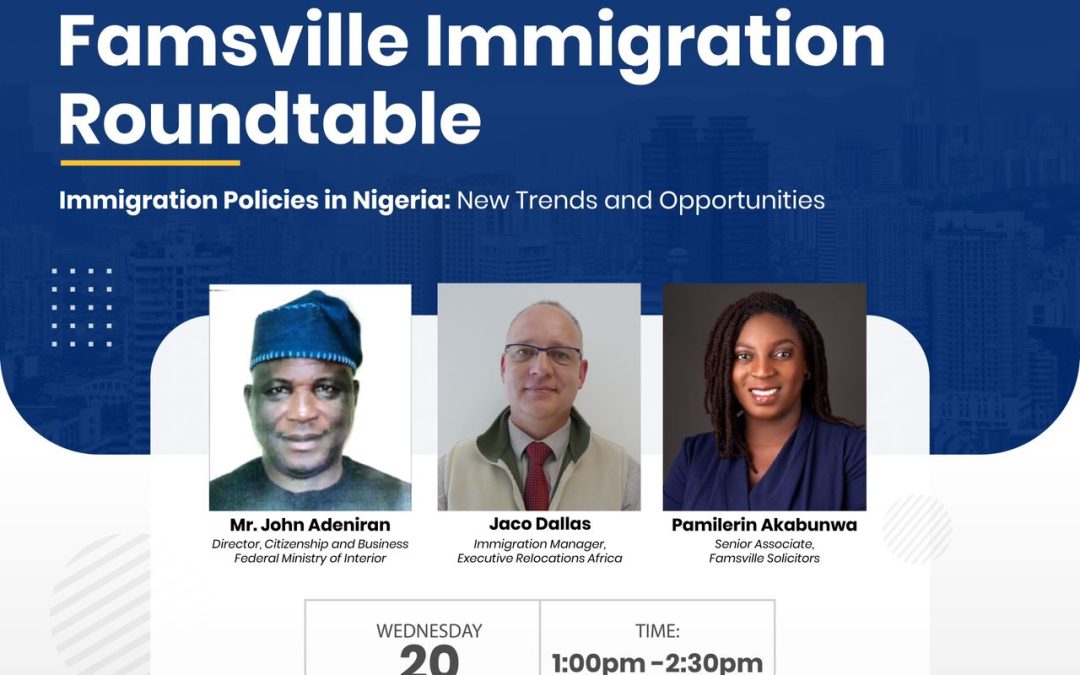
by Legalnaija | Sep 18, 2023 | Blawg

🚀 Exciting News Alert! 🚀
Prepare to embark on an eye-opening journey into the world of immigration policies in Nigeria with Famsville, a Pan-African commercial law firm.
Join us for an exclusive immigration roundtable on the topic “Immigration Policies in Nigeria: Emerging Trends and Opportunities.”
Date: Wednesday, September 20th, at 1:00 PM (GMT+1).
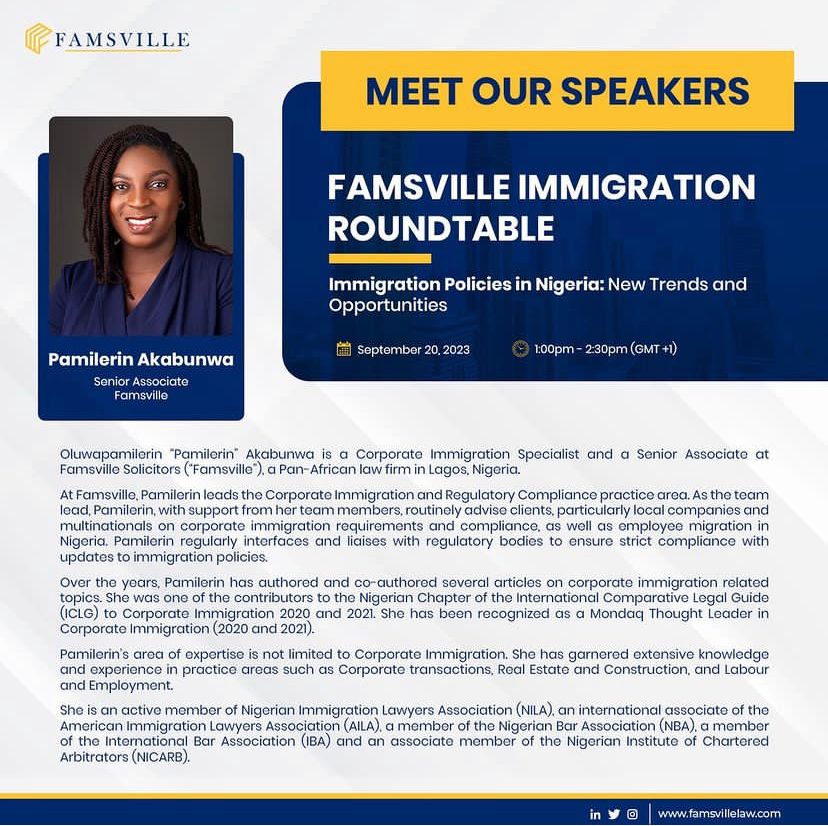
What you will learn:
➢ Visa Categories: Understand benefits and challenges of new visa classes.
➢ Legal Framework: Explore laws and regulations governing visas.
➢ Permanent Residency: Learn eligibility, requirements, and procedures.

➢ Compliance Challenges: Identify regulatory hurdles and processing times
➢ And so much more
Don’t miss out on this opportunity to expand your knowledge and seize new possibilities.
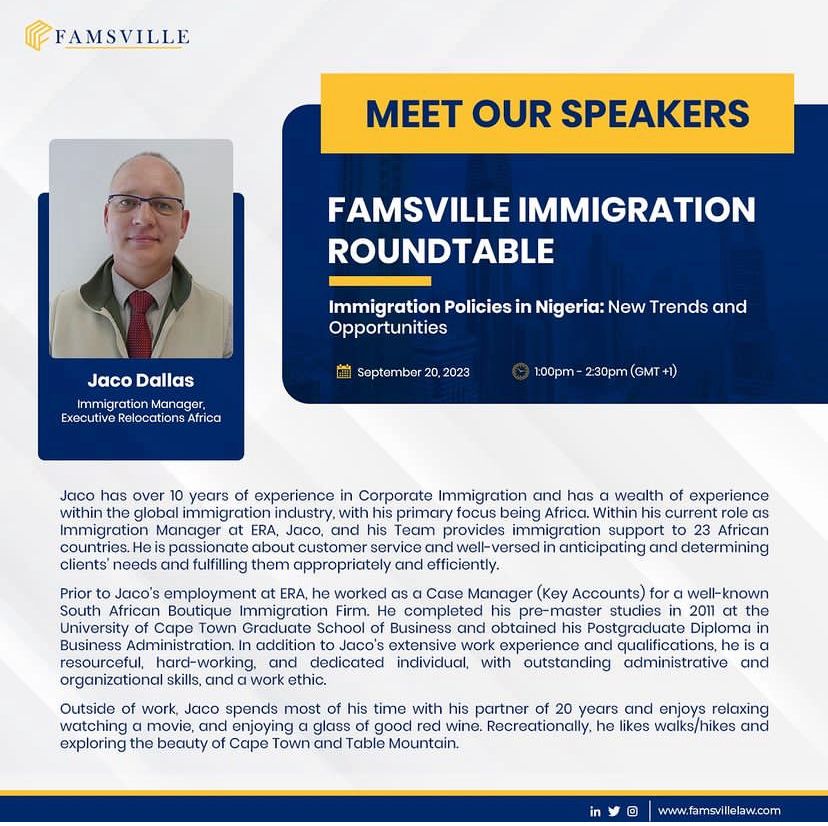
Register to secure your spot now: https://bit.ly/RegistrationLinkFamsville
#FamsvilleWebinar #NigeriaImmigration #FamsvilleWebinar #NigeriaImmigration #Famsvilleimmigrationroundtable #legalevents #immigrationconsultant

by Legalnaija | Jul 3, 2023 | Blawg, Family Law
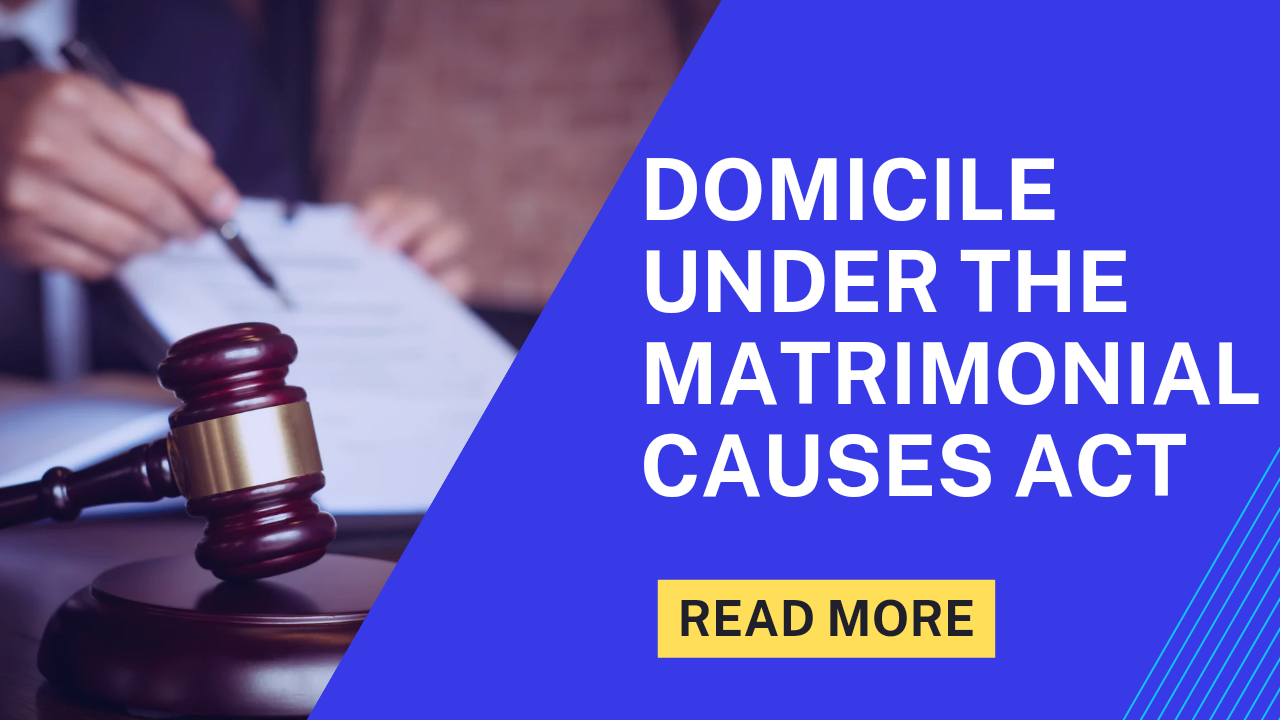
In private international law, the principle of domicile was first propounded and developed in the Middle Ages by the Italian school of Post glossators, as a result of the development in the ease of mobility of persons from one state to another. This led to the reasoning that persons should be attributed to a particular legal system. The reason for this line of thinking includes the perceived importance attached to the notion of belonging to a country/state; this Martin Wolff appropriately posited as ascribing to any given individual a legal ‘centre of gravity’; and determining which legal system has jurisdiction in cases pertaining to personal law.[i]
According to the Blacks Law Dictionary, Domicile is the place where a person has fixed his habitation and has a permanent residence, without any present intention of removing therefrom. The different types of Domicile are domicile of origin, domicile of dependency and domicile of choice. The first domicile which a person acquires is the domicile of origin. This type of domicile is determined by the domicile of the parents at the point of a person’s birth, as determined in Bell v Kennedy.[ii] Domicile of choice is acquired by a person of full capacity. This is gotten by fulfilling all the requirements of domicile of the particular state one wants to get domiciled in. This can be acquired by an adult of full mental capacity acting in his own will to permanently settle elsewhere. Once the domicile of choice is acquired, the domicile of origin of such person goes into abeyance. Domicile of Dependence focuses on married women, children under 21 years, and mentally disordered persons. Married women acquire domicile being that of the husband upon celebration of a valid marriage. This domicile of dependence can apparently be terminated either by divorce or death of one of the couple.
The topic of domicile is important as it is a guide for determining the question of personal law, especially when it relates to Divorce Proceedings, as the Matrimonial Causes Acts in Section 2, states that a petitioner must be domiciled in Nigeria at the time of his filing of a petition for divorce. This was illustrated in the case of Omotunde v. Omotunde (2020) LPELR 10194 CA, wherein the petitioner, who had been consistently domiciled in the United States of America since 1993 up to the time he filed his petition on the 21st day of April, 1998. The Court held it cannot be said of him that as at 21/4/98 when he was filing his petition through his learned Counsel, he was domiciled in Nigeria.
Regarding female spouses, due to the fact that Nigeria inherited its laws from the United Kingdom, Nigeria adopted the position that a wife inherits the domicile of her husband. It’s important to note that this concept is an archaic and anachronistic one which views the wife as incapable of having an independent existence from the husband, therefore appurtenant to the domicile possessed by the husband. Law being a dynamic element: forward thinking jurisdictions such as England has abolished this by enacting the Domicile and Matrimonial Proceedings Act 1973 which provides that married women can have domicile independent of their husbands. This has been exemplified in cases such as Inland Revenue Commissioners v Duchess OF Portland.[iii] The existence of this class of domicile eludes common sense and objective reasoning especially because of the fact that the woman before and during the existence of marriage may be subject to different laws from that of the husband and by reason of the relationship that exists between them, will not offer justification for the imposition of the domicile of the husband upon the wife. Lord Denning in relation to this point stated, “the last barbarous relic of a wife’s servitude”.
On the side of judicial activism, the Nigerian court has put a step forward in the abolishing of this class of domicile. The court in Bhojwani v Bhojwani per Uwaifo JCA stated that;
“there are strictly two types of domicile. One is domicile of origin and the other, domicile of choice. There is no separate domicile known as domicile of dependence as was canvassed by Professor Adesanya in the present case and also in Osibamowo v. Osibamowo, and there in that case accepted by this court[iv].
While the issue of domicile continues to come up in legal matters, it will be interesting to see the decision of the Court in similar matters going forward.
Read more law articles on www.legalnaija.com/blawg
[i] Martin Wolff, Privte International Law (2nd ed. Clarendon Press 1950) 5
[ii] (1868) UKHL 566 1.
[iii] [1982] BTC 65.
[iv] Ewenike E. Ebuka and Araka Chukwunweike. (2023). Gauging The Current Position Of The Principle Of Domicile In Nigeria. [Online]. DjetLawyer. Available at: https://djetlawyer.com/gauging-the-current-position-of-the-principle-of-domicile-in-nigeria/ [Accessed 28 June 2023].
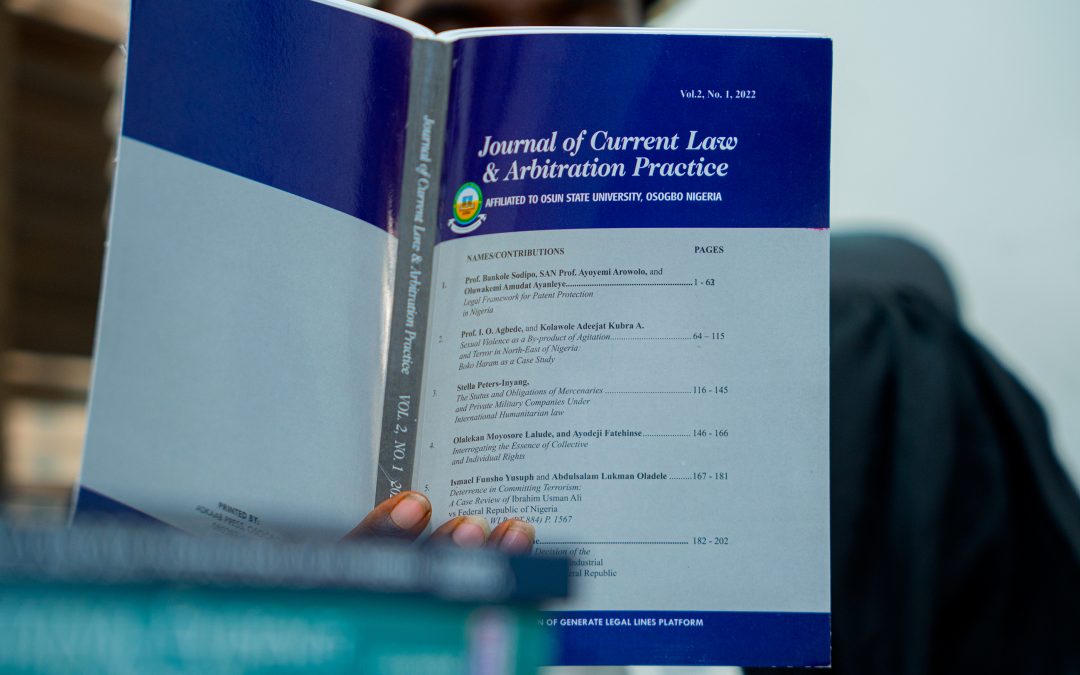
by Legalnaija | May 8, 2023 | Blawg

This journal is a triannual reportage of essays in all branches of Law and Alternative Dispute Resolution (ADR), with a particular focus on evolving areas like Medical Law, Arts & Entertainment Law, Information Technology, Energy Law and much more.
There are currently 4 volumes and you can see the topics on Vol 1 – 3 below;
Volume 1 No1 2020
- Mediation and conciliation: Traditional rulers ‘Panacea for Settling Land Disputes’ – Olufemi Ogunleye and Olusesan Oliyide.
- The Lagos State Street Trading and Illegal Markets Law: Making Norms Work– Adedotun Onibokun and N. U donmba.
- Fragility of Law and the Environment Nigeria as a Case Study – Gbadamosi, Oladele Abass
- Discourse on Legal Scholarship: The Emergence of Sociology of Law as a Discipline– Akuchie Henry A.
- Online Dispute Resolution (ODR): A Viable Solution to Speed and Efficiency Issues in ADR– Morenike, Obi-Farinde FCIArb
- Providing a Legal Framework for the Committal of the Mentally ill in Nigeria– Deborah Okemiri-Ikonne
- ODR in Africa:The Emergent Face of Dispute Resolution Post Covid 2019 – Morenike, Obi-Farinde FCIArb
- Exploring Alternative Dispute Resolution In Medical Malpractice Disputes In Nigeria – wadzi Vivian aboki, FCIrb
- Mekwunye v Imoukhuede – The Consistent Strides of Nigerian Arbitration (or, is it?) – Adebayo Adenipekun SAN, FCIArb, FCArb.
Volume 1 No2 2021
- The Effect Of Corporate Governance On The Performance Of Money Deposit Banks In Nigeria – toluwase T. Ajibade LLB,B.L,ACIArb, and Deji olanrenwaju LL.B,LLM, B.L, MSC, FCIB, FIMA, FCMR.
- Legal and Other Impacts of Foreign Investments in Nigeria since the second Republic – Olusesan Oliyide LL.M (Lagos) , Chinaka Emmanuel LL.M(BU) and Bunmi Osifeso,LL.M.(OAU).
- Getting it right between Criminal Liability and Anti- Social Behaviour – Akuchie Henry, a. b.Sc, (Hons) M.A (Houston), JD (California), LL.M (Virginia), and LL.D (South Africa).
- The imperative of establishing appellate court over Industrial Disputes in Nigeria – Festus Gboyega Oyebade B.Sc, LLB, BL, LLM (Ife). MA. Med, Mphil Law (Ife), Ph.D (Ibadan)
- Arbitration in Criminal Matters: Hoax or a possibility – Hon. Ipoola Aderemi Binuyo LL.B, ll.m, m.phil (Ife), B.L., FCIArb.
- The Companies and Allied Matters Act 2020 – Pastor ‘Niyi Odunsi
- Obafemi Awolowo University vs Inaolaji Builders Limited: A Needless Judicial Intervention– Funmi Roberts LL.M,C.Arb., FNCIArb., F.IOD
Vol.2, No.1.2022
- Bankole Sodipo, SAN, Prof.AYOYEMI Arowolo, and Oluwakemui Amudat Ayanleye – Legal Framework for Patent Protection in Nigeria.
- I.O. Agbedde and Kolawole Adeejat Kubra A. – Sexual Violence as a By-product of Agitation and Terror in the North-East of Nigeria : Boko Haram as a case study
- Stella Peters-Inyang – The Status and Obligations Of Mercenaries And Private Military Companies Under International Humanitarian Law.
- Olalekan Moyosore Lalude, and Ayodeji Fatehinse – Interrogating the Essence of Collective and Individual Rights.
- Ismael Funsho Yusuph and Abdulsalam Lukman Oladele – Deterrence in Committing Terrorism: A case Review of Ibrahim Usman Ali vs Federal Republic of Nigeria (2017) ALL WLR (PT 884) P.1567
- Francis Ohiwere Oleghe – A Critical Review of the Decision of the Decision of the High Court in Process & Industrial Developments Limited v The Federal Republic of Nigeria.
Vol.2, No 2, 2022
- Dr Effiong Esu – A Critical Appraisal Of Derivative Action Under The Companies And Allied Matters Act 2020
- Ogunleye, Olufemi Adewunmi, LL.M– Protecting Religious Minorities within Nigeria for African Traditional Religion: A challenge for international Human Right and National Laws.
- Francis ohiwere Oleghe – A Critical Analysis of Law and Justice as Instrument for Social Engineering in Nigeria.
- Gazu Gideon Nyuimbe – Reinvogorating the Ethics of Corporate Governance in the Nigerian Banking Sector
- Justice Adedotun Onibokun– Renewable Energy and the law in Nigeria
- Oluwagbemiga Atere – The Denovo effect of the Fade to periphery principle in the court of arbitration for sports . a Threat to the Right of Appeal and and its Legal Merits.
- Olufunmilola Olabode – Extending The Arbitration Agreement To Non- Signatories : A Contravention of The Consemsual Nature of Arbitration?
- Bolarinwa Levi Pius – Arbitration of Securities Disputes in Nigeria: Issues And Viable Reforms.
To order copies of the Journal, follow these links below or contact 09029755663.
- Get your copy of Vol 1 No. 1
- Get your copy of Vol 1 No. 2
- Get your copy of Vol 2 No. 1
- Get your copy of Vol 2 No 2










 Arome Abu is the Managing Partner of TCLP.
Arome Abu is the Managing Partner of TCLP.
 Bio: Adeola is an IP lawyer, transactional and corporate governance practitioner with local expertise and global outlook. She curates corporate commercial contents on legal advisory and regulatory compliance needs for start-ups, SMEs and corporate entities seeking to establish, run and scale their businesses in Nigeria. She can be reached by sending an email to adeola@aeolawpractice.com
Bio: Adeola is an IP lawyer, transactional and corporate governance practitioner with local expertise and global outlook. She curates corporate commercial contents on legal advisory and regulatory compliance needs for start-ups, SMEs and corporate entities seeking to establish, run and scale their businesses in Nigeria. She can be reached by sending an email to adeola@aeolawpractice.com







